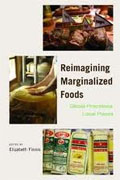Reimagining Marginalized Foods
Elizabeth Finnis
book reviews:
· general fiction
· chick lit/romance
· sci-fi/fantasy
· graphic novels
· nonfiction
· audio books
· author interviews
· children's books @
curledupkids.com
· DVD reviews @
curledupdvd.com
newsletter
win books
buy online
links
home
for authors
& publishers
for reviewers

 |
Reimagining Marginalized Foods: Global Processes, Local Places Elizabeth Finnis University of Arizona Press Hardcover 168 pages April 2012 |
|
The old saying is "One man's meat is another man's poison." In modern terms, this could be transformed to "One man's raw fish is another man's sushi." Food is a political issue, an environmental problem, and very often a cultural conflict. In this book, a number of writers examine how different people eat, and what happens to their food as it moves away from home and hearth and takes on different meanings as it encounters different consumers.
Richard Wilk, Provost Professor of Anthropology at Indiana University, tackles the subject of "Loving People, Hating What they Eat." Marginal foods are associated with poverty, with lower class, with ignorance of health idealism. You can see what people eat and classify them in certain ways by that observation. "Poor rural people may classify snails and eels as subsistence foods, while rich urban people classify them as gourmet treats, and the middle class treats both as inedible and disgusting." In Belize, Wilk found that whereas people were relatively placid about their food likes, they were strongly opinionated and emotional about their dislikes. One traditional meal called cowfoot soup was especially associated with poverty and ignorance, with Creole culture and regression. But as Creole culture took on a voguish aspect, cowfoot soup began to re-enter the mainstream of acceptability, just as Japanese foods (including sushi) once considered bizarre, with negative associations from World War II, are now trendy and sought after in the US. Wini P Utari, a doctoral candidate in Anthropology at the University of Kentucky, specializes in Indonesian studies and writes here about sinoggi, a sour, sago-based starch consumed by Indonesians. One of Utari's contacts reported that he "had to eat sinoggi" every day, just as I was once told in the Dominican Republic that if the local people didn't have rice and beans every day, they "would die." Yet the author was not offered sinoggi initially when she visited in village settings; she soon learned that people were accustomed to being looked down on for consuming sinoggi, partly because it is eaten with the fingers. Local people with a sense of class pride will serve rice "and keep their sinoggi party private." Focusing on “food tourism” in Mexico, Lois Stanford, a cultural anthropologist at the University of New Mexico who researches southwestern dietary habits, shines a spotlight on what happens “When the Marginal Becomes the Exotic.” A yearly festival for women chefs in the highlands of Michoacán, Mexico, gradually turned into a highly formalized and academic affair. In one group discussion at the festival, when asked to share her recipes, one of the indigenous cooks objected that “her grandmother had handed these recipes down to her, and they were not hers to share.” She went on to protest, justifiably it seems to me, that if she shared her secrets, then “what will you need me for?” Arguably, the farther a food moves from its source, the less cultural significance it can embody. As it is processed, packaged and delivered to faraway places, it loses the meaning and perhaps, the flavor as well. Once lost, that is hard, if not impossible, to recover. Originally published on Curled Up With A Good Book at www.curledup.com. © Barbara Bamberger Scott, 2012 |
|
|
|
 Click here to learn more about this month's sponsor! |
|
| fiction · sf/f · comic books · nonfiction · audio newsletter · free book contest · buy books online review index · links · · authors & publishers reviewers |
|
| site by ELBO Computing Resources, Inc. | |
 Often misplaced peoples long for home foods. I worked in the UK once in an international college where African and Latin students wanted corn/maize meal to make the foods like sudza and tortillas that they were accustomed to. Sometimes, without their "staple foods,"
people feel like they are slowly dying, but they may hide their food preferences from foreigners out of embarrassment. This book’s editor, Elizabeth Finnis, works with farmers in India and Paraguay, examining “issues of agriculture and dietary transitions, environment--and how small-scale farmers cope with social and physical-environmental changes.” She states in her introduction that that "in discussing marginal foods and non-elite populations, we consider how marginality plays out in specific locales and times, and the multiple ways it may be manifested and articulated.”
Often misplaced peoples long for home foods. I worked in the UK once in an international college where African and Latin students wanted corn/maize meal to make the foods like sudza and tortillas that they were accustomed to. Sometimes, without their "staple foods,"
people feel like they are slowly dying, but they may hide their food preferences from foreigners out of embarrassment. This book’s editor, Elizabeth Finnis, works with farmers in India and Paraguay, examining “issues of agriculture and dietary transitions, environment--and how small-scale farmers cope with social and physical-environmental changes.” She states in her introduction that that "in discussing marginal foods and non-elite populations, we consider how marginality plays out in specific locales and times, and the multiple ways it may be manifested and articulated.”